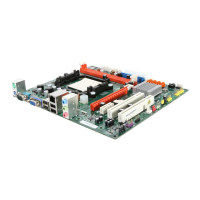
Do you have a question about the ECS MCP61M-M3 and is the answer not in the manual?
| Number of memory slots | 2 |
|---|---|
| Maximum internal memory | 8 GB |
| Processor socket | Socket AM3 |
| Processor manufacturer | AMD |
| USB 2.0 connectors | 3 |
| Power fan connector | Yes |
| Number of SATA connectors | 4 |
| USB 2.0 ports quantity | USB 2.0 ports have a data transmission speed of 480 Mbps, and are backwards compatible with USB 1.1 ports. You can connect all kinds of peripheral devices to them. |
| Ethernet LAN (RJ-45) ports | 1 |
| Audio chip | VIA VT1705 |
| Power source type | ATX |
| Audio output channels | 6.1 channels |
| Motherboard form factor | micro ATX |
| BIOS memory size | 64 Mbit |
Introduces the MCP61M-M3 motherboard and its target market.
Details the processor, chipset, memory, audio, and onboard LAN features.
Lists expansion slots, connectors, and rear panel I/O ports.
Explains the AMI BIOS capabilities for system configuration.
Identifies physical components on the motherboard via labels and diagram.
Essential safety guidelines for handling computer components and installation.
Guidance on selecting a case and physically mounting the motherboard.
Explains how to set jumpers for system configuration options.
Detailed procedure for safely installing the CPU, including thermal grease and fan.
Guide for installing DDR3 SDRAM modules into the DIMM slots.
Details the types and purposes of PCI Express and PCI expansion slots.
Instructions for installing hard drives, CD-ROM drives, and floppy drives.
Explains how to connect external devices to the motherboard's rear I/O ports.
Guides the connection of internal case components like fans, power, and LEDs.
Instructions on how to access the BIOS Setup Utility during system startup.
Guide to loading default BIOS settings, often for troubleshooting.
Displays basic system information like date, time, and detected drives.
Accesses advanced system configuration options, including boot order.
Configuration for DRAM frequency, timing, and memory controller modes.
Settings for onboard devices like IDE, SATA, Audio, and LAN controllers.
Options for configuring system power saving features and wake-up events.
Monitors system voltages, temperatures, and fan speeds for hardware health.
Allows adjustment of CPU clock speed and system bus frequency.
Restores BIOS to optimized default settings, often for troubleshooting.
Provides instructions for downloading and installing BIOS updates.
Information about the bundled software and drivers on the installation disc.
Guide to using the autorun feature for installing drivers and utilities.
Instructions for manually installing drivers if the automatic process fails.
How to create RAID arrays without OS modification.
How to configure RAID arrays for OS installation.
Detailed steps for setting up RAID arrays in BIOS.
Installing NVIDIA RAID drivers during Windows setup.
Overview of eJIFFY as a fast boot Linux environment for quick access.
Steps to install eJIFFY software and enable the feature in BIOS settings.
Guide to changing display language and keyboard layout within eJIFFY.
How to launch eJIFFY and understand its interface icons.
Diagnosing and resolving issues encountered during initial PC assembly.
Troubleshooting scenarios where the system lacks power or display output.
Addressing startup problems that occur after the PC has been in use.
Provides advice for routine maintenance to prolong motherboard life.
A visual guide to systematically diagnose and resolve common PC issues.
